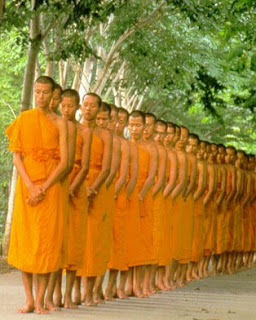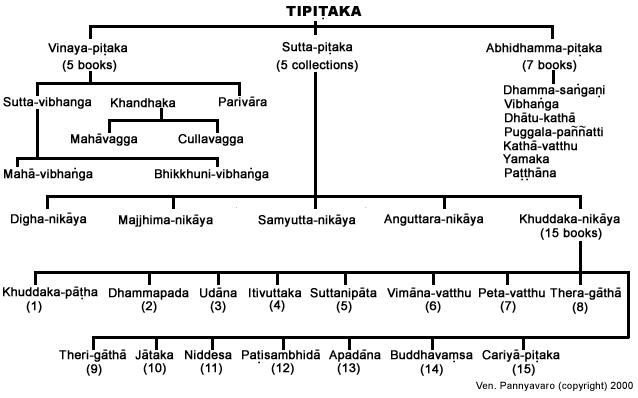First Buddhist Council  The First Council, as it is known to Buddhist history, took place at Rajgir, the capital of the Magadha kingdom. The Buddha's most important disciples were asked to recite his teachings from memory. The first to recite was Ananda, the Buddha's cousin, attendant and constant companion for more than 30 years. Demonstrating impressive powers of memorization, he recited not only everything he had heard, but the place in which each discourse was given. Other monks were then asked to confirm Ananda's recollection.  It was also at this council that the Buddha's teachings were divided into three categories or "baskets" (pitaka): discourses, discipline and higher knowledge. The Tripitaka that was formed at this meeting is the same canon used by Buddhists today. |
According to this record the incident which prompted the Elder Mahakassapa to call this meeting was his hearing a disparaging remark about the strict rule of life for monks. The monk Subhadda, who had ordained late in life, upon hearing that the Buddha had expired, voiced his resentment at having to abide by all the rules for monks laid down by the Buddha. Many monks lamented the passing of the Buddha and were deeply grieved but Subhadda spoke up to show happiness and relief that Buddha was gone. |
Second Buddhist Council  The group who stayed called themselves the Elders (Thera in Pali). They felt they were in keeping with the original spirit of the Buddha's teachings. The other group, the Great Community (Mahasanghika in Sanskrit), interpreted Buddha's teachings more liberally, but in a way that they felt was more true to his intentions. These two groups would eventually evolve into Theravada and Mahayana Buddhism. | (4th century BCE)
Although it is unclear exactly what happened at this council, we do know that it resulted in a split in the Buddhist community. A large group of monks were either expelled or left by choice because they did not agree with the other group's interpretations of the Buddha's teachings. Within 200 years of the Buddha's death, there were 18 schools of Buddhism in India. This is perhaps not surprising, given that the Buddha taught in a slightly different way for each situation, was averse to setting down doctrine and never wrote anything himself. Moreover, Buddhism had now spread to places with different languages and customs, and therefore different perspectives on the dharma. |
Third Buddhist Council The reason for convening the Third Buddhist Council is reported to have been to rid the Sangha of corruption and bogus monks who held heretical views.  Disputes on points of doctrine lead to further schisms, spawning the Sarvastivadin and Vibhajjavadin sects. The Abhidhamma Pitaka is recited at the Council, along with additional sections of the Khuddaka Nikaya. The modern Pali Tipitaka is now essentially complete, although some scholars have suggested that at least two parts of the extant Canon — the Parivara in the Vinaya, and the Apadana in the Sutta — may date from a later period. | (250 BCE)
|
Fourth Buddhist Council Fourth Buddhist Council is the name of two separate Buddhist council meetings. The first one was held in the 1st century BC, in Sri Lanka. In this fourth Buddhist council the Theravadin Pali Canon was for the first time committed to writing, on palm leaves. The second one was held by the Sarvastivada school, in Kashmir around the 1st century AD. | (1st century BCE or CE)
|
Fifth Buddhist Council | · The Fifth Buddhist council took place in Mandalay, Burma (Myanmar) in 1871 AD in the reign of King Mindon. · The chief objective of this meeting was to recite all the teachings of the Buddha according to the Theravada Pali Canon and examine them in minute detail to see if any of them had been altered, distorted or dropped. . · It was presided over by three Elders, the Venerable Mahathera Jagarabhivamsa, the Venerable Narindabhidhaja, and the Venerable Mahathera Sumangalasami in the company of 2,400 monks. · Their joint Dhamma recitation lasted five months. |
Sixth Buddhist Council | · The Sixth Buddhist Council was a general council of Theravada Buddhism, held in a specially built cave and pagoda complex at Kaba Aye Pagoda in Yangon, Burma. · The council was attended by 2,500 monastics from eight Theravada Buddhist countries. · The Council lasted from Vesak 1954 to Vesak 1956, its completion coinciding with the traditional 2,500th anniversary the Buddha's Parinibbāna. In the tradition of past Buddhist councils, a major purpose of the Sixth Council was to preserve the Buddha's teachings and practices as understood in the Theravada tradition. · Over the two-year period, monks (sangīti-kāraka) from different countries recited from their existing redaction of the Pali Canon and the associated post-canonical literature. · As a result, the Council synthesized a new redaction of the Pali texts ultimately transcribed into several native scripts. |
